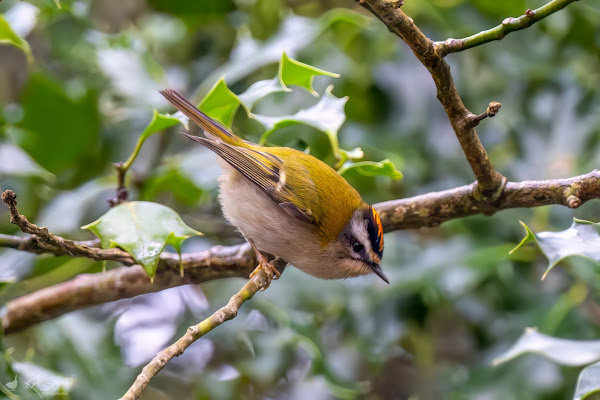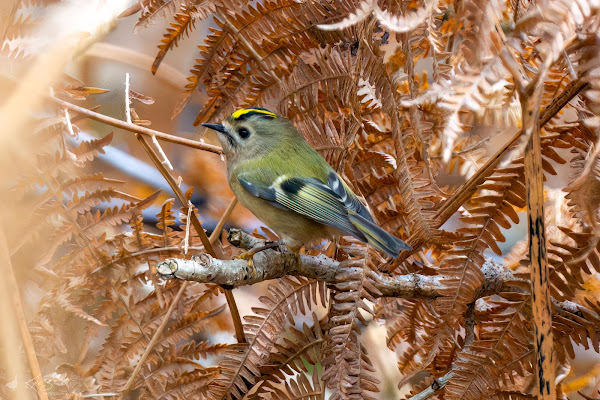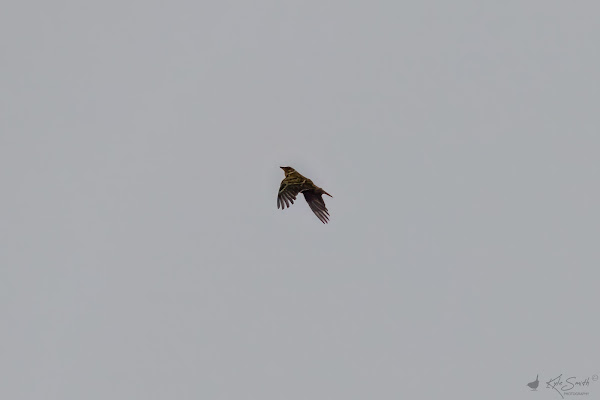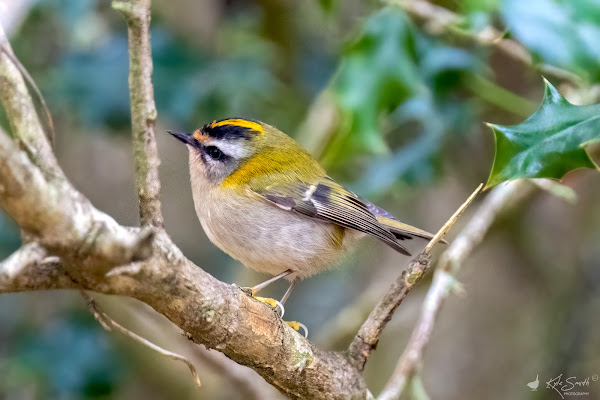We decided on a return trip to Acres Down, aiming to tick a few species we had missed on our previous visit. Reports of lesser spotted woodpecker had been sporadic since our last trip, and we hadn't yet tried to spot goshawk or woodlark.
On arrival, the car park was busy once again, but as we approached the favoured tree of the lesser spotted woodpecker, we noticed fewer birders compared to our previous visit. Perhaps some visitors had ventured on walks, some accompanied by their dogs.
While crossing the car park, we heard the calls of firecrests and once again managed to spot and track an individual in the holly across from us. I attempted to capture a photo, but the early morning light and the shade under the trees made it a challenge.
We waited for a while watching the tree and hearing occasional drumming to our right and behind but no signs of any woodpeckers passing through. I eventually saw a coal tit, having listened to them repeatedly on our last visitt and not seen them. Kev @kev07713 wandered off and watched a flock of finches and picked out a couple of bramblings which I thought I'd pick up when we went in that direction - they were gone when we looked later and I’d lost my chance.
No one had seen the woodpecker all morning and so we decided to take a chance and go for a walk and make use of our time here - it may never show. We'd heard some drumming from some distance behind and headed in that direction to look for likely locations. Unfortunately, none of them held our woodpecker although we did see marsh tits, treecreepers, a firecrest, and on the return a pair of goldcrests.
We stopped to check if any woodpeckers had been seen but none had so we went back towards the car and out onto the heath. On our last visit we had looked from here but ventured no further but now walked round to the point and overlooking heather clad slopes. Three birders were ahead of us, and we stopped near to them, listening to woodlarks.
Before long, our first woodlark appeared high in the distance behind us. Several more and one-by-one followed suit, taking flight and soaring into the sky above. Though often distant and silhouetted against the grey sky, their song betrayed their presence. The woodlark is a diminutive ground-nesting bird renowned for its melodious and intricate song and has a surprisingly powerful song despite its size. Their calls resonate across large distances, particularly in expansive habitats like grasslands, heathlands like that we were on, or open woodlands.
At this time of year you can also observe buzzards engaging in various displays and behaviours as they prepare for the breeding season. This can involve calling, chasing off other buzzards, or even engaging in aerial conflicts. We counted more than five buzzards out front and another couple to our left - while the five were mainly soaring, the two to our left were engaging in some territorial disagreement.
Like buzzards, goshawks exhibit territorial behaviour, especially during the breeding season. So, in February, they are often diligently defending their territories against intruders or competing goshawks. Goshawk males seeking mates stake out territories using aerial acrobatics and vocalizations, make it an opportune time to observe them. Luckily, we managed to spot an individual beyond a distant line of trees, though its presence was discernible only through Kev's scope.
We set off across the heath to see if we could find a Dartford warbler, a birder having reported seeing one around the gorse on the heath on our last visit. We searched back and forth but came up with nothing. While searching we saw ponies and two brought the Dr Doolittle 'push-me-pull-you' to mind.
Eventually we returned towards the car and stopped as we encountered another marsh tit and views of firecrest in better light.
Year list: 131











No comments:
Post a Comment